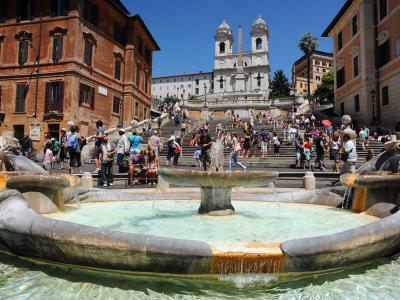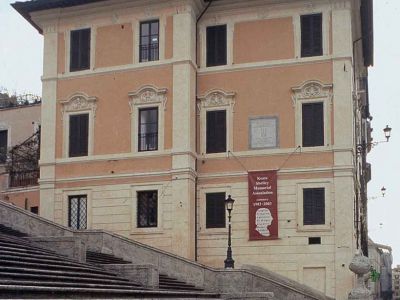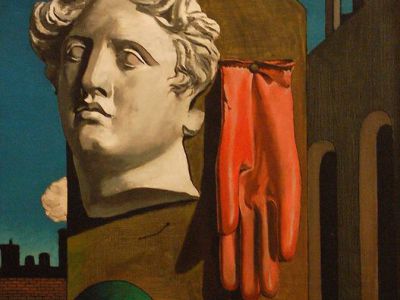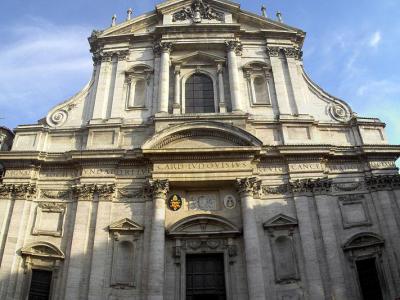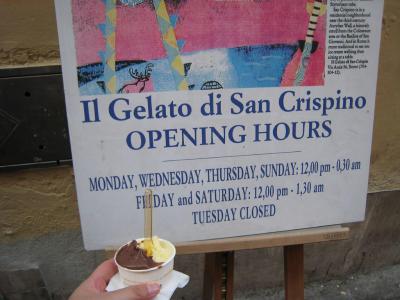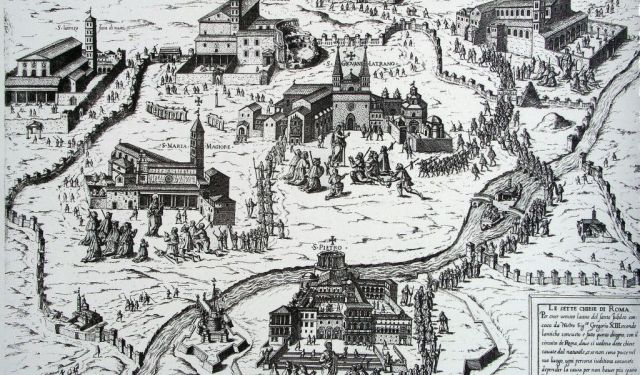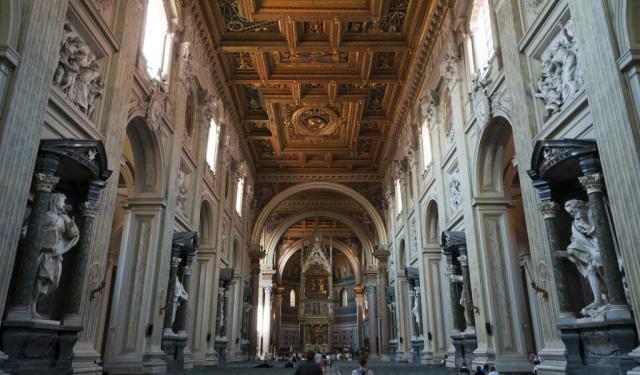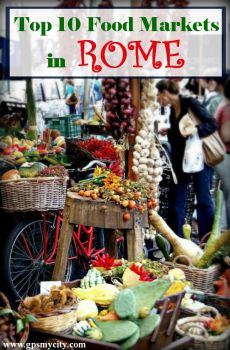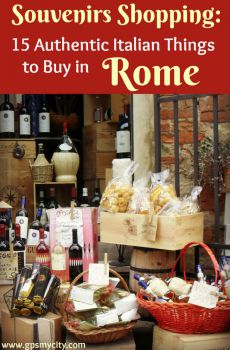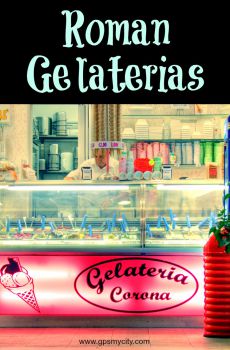Spanish Steps to Trevi Fountain (Self Guided), Rome
An established tourist mecca, today's Rome is hardly imaginable without two of its much loved attractions – the Spanish Steps and the Trevi Fountain. Magnets for tourists as they are, these two sights are connected to a number of other, not less worthy of attention locations, such as the Fountain of the Longboat or Piazza Colonna and its centerpiece, the Column of Marcus Aurelius, to mention but a few.
The time-honored tradition of decorating the Spanish Steps with hundreds of flowering azalea plants dates back to nearly a century ago. Stop by the fountain at the base, walk half-way up the steps and look down; go to the top and marvel at the view down the steps and over the City. This then leads you to Piazza di Espagna and its surrounding attractions, including the Keats-Shelley Memorial House and the Giorgio de Chirico House Museum, which showcases real pieces of a very talented life.
The beautiful, rectangular Piazza Colonna is itself surrounded by several imposing buildings, in addition to the obligatory column and fountain. Take the time to look at the column’s carvings, then continue with one of Rome’s most amazing churches, dedicated to St. Ignatius of Loyola – a marvel in terms of over-the-top baroque interiors.
Save the Trevi Fountains for last, as they are best seen towards the evening when the foot traffic dies down. Beautiful beyond anything you can imagine, one would not mind turning into a fish and living in the fountains forever! Instead, you could pick a flavor from the nearby Gelato di San Crispino and call it a day.
For a great day out in this fabulous area, pick a day with nice weather and follow our self-guided walking tour.
Getting to Sight #1. The first tour stop (Spanish Steps) can be reached by Bus 119, 160, 61, 63, 913; also 40 Express and 116 electric bus, Train: FL5, R, RV, Metro: line A
The time-honored tradition of decorating the Spanish Steps with hundreds of flowering azalea plants dates back to nearly a century ago. Stop by the fountain at the base, walk half-way up the steps and look down; go to the top and marvel at the view down the steps and over the City. This then leads you to Piazza di Espagna and its surrounding attractions, including the Keats-Shelley Memorial House and the Giorgio de Chirico House Museum, which showcases real pieces of a very talented life.
The beautiful, rectangular Piazza Colonna is itself surrounded by several imposing buildings, in addition to the obligatory column and fountain. Take the time to look at the column’s carvings, then continue with one of Rome’s most amazing churches, dedicated to St. Ignatius of Loyola – a marvel in terms of over-the-top baroque interiors.
Save the Trevi Fountains for last, as they are best seen towards the evening when the foot traffic dies down. Beautiful beyond anything you can imagine, one would not mind turning into a fish and living in the fountains forever! Instead, you could pick a flavor from the nearby Gelato di San Crispino and call it a day.
For a great day out in this fabulous area, pick a day with nice weather and follow our self-guided walking tour.
Getting to Sight #1. The first tour stop (Spanish Steps) can be reached by Bus 119, 160, 61, 63, 913; also 40 Express and 116 electric bus, Train: FL5, R, RV, Metro: line A
How it works: Download the app "GPSmyCity: Walks in 1K+ Cities" from Apple App Store or Google Play Store to your mobile phone or tablet. The app turns your mobile device into a personal tour guide and its built-in GPS navigation functions guide you from one tour stop to next. The app works offline, so no data plan is needed when traveling abroad.
Spanish Steps to Trevi Fountain Map
Guide Name: Spanish Steps to Trevi Fountain
Guide Location: Italy » Rome (See other walking tours in Rome)
Guide Type: Self-guided Walking Tour (Sightseeing)
# of Attractions: 8
Tour Duration: 1 Hour(s)
Travel Distance: 2.0 Km or 1.2 Miles
Author: DanaOffice
Sight(s) Featured in This Guide:
Guide Location: Italy » Rome (See other walking tours in Rome)
Guide Type: Self-guided Walking Tour (Sightseeing)
# of Attractions: 8
Tour Duration: 1 Hour(s)
Travel Distance: 2.0 Km or 1.2 Miles
Author: DanaOffice
Sight(s) Featured in This Guide:
- Scalinata di Trinita dei Monti (Spanish Steps)
- Piazza di Spagna & Fontana della Barcaccia (Spanish Square & Fountain of the Longboat)
- Keats-Shelley Memorial House
- Casa Museo di Giorgio de Chirico (Giorgio de Chirico House Museum)
- Piazza Colonna & Colonna di Marco Aurelio (Column Square & Column of Marcus Aurelius)
- Chiesa di Sant' Ignazio di Loyola (Church of St. Ignatius of Loyola)
- Piazza di Trevi & Fontana di Trevi (Trevi Square & Trevi Fountain)
- Gelato di San Crispino
1) Scalinata di Trinita dei Monti (Spanish Steps) (must see)
The Spanish Steps, a monumental stairway of 135 steps, holds the distinction of being the longest and widest in Europe. The steps link Spanish Square, at the base, with the Trinity of the Mountains Square at the top.
The stairway was completed under Pope Clement XI in 1717, deriving its name from the nearby Spanish Embassy to the Holy See. Financed in part by a French diplomat, it features Baroque elements, inspired by garden stairs, and incorporates symbolic decorations such as the Bourbon heraldic lily flowers and papal eagles.
As a cultural and seasonal hub hosting public events such as Christmas cribs, spring azalea displays, and a flower market, the Spanish Steps have captivated artists and people of letters since the 18th century. Among them was the renowned English poet, John Keats, who lived and died practically next door. His house, at the base of the steps (located to the right, if you face the stairs), is now a museum.
Other nearby landmarks include the Ferrari di Valbona Palace, redesigned in 1936, and Babington's tea room, a resilient establishment that has withstood two world wars and numerous adversities, ultimately becoming a beloved tourist attraction.
The steps' cinematic appeal also made them a backdrop for numerous films, including the Hollywood blockbuster “Roman Holiday” made in 1953, starring Audrey Hepburn and Gregory Peck. In the scene where Joe Bradley, played by Peck, meets Princess Ann, played by Hepburn, she sits on the steps, enjoying the view and eating ice cream. Fresh after the haircut, the princess takes compliments for her new look and makes up a story that she has run away from school. She accepts his proposal to spend the day together before she returns, and thus the Roman Holiday story begins!
Other filmmakers also made a mark on the steps, such as “The Talented Mr. Ripley” movie with Matt Damon, shot in 1999, and “Mission: Impossible – Dead Reckoning Part One,” featuring Tom Cruise, which premiered at the steps on June 19, 2023.
Consequently, the Spanish Steps became a magnet for aspiring models, affluent Romans, international travelers, and people from all walks of life. The tradition of gathering here is deeply ingrained in the locals and visitors alike. Today, the steps are protected by strict regulations against loitering, eating, or damaging, with heavy fines introduced to maintain decorum.
Tip:
The staircase offers picturesque views of Rome from its pinnacle, particularly at sunset-a truly unbeatable sight!
The afternoon and late hours are the best for visiting, so to avoid the heat of the day.
Alongside tourist activities such as carriage rides, you'll find nearby an array of shops and bars worth exploring.
The stairway was completed under Pope Clement XI in 1717, deriving its name from the nearby Spanish Embassy to the Holy See. Financed in part by a French diplomat, it features Baroque elements, inspired by garden stairs, and incorporates symbolic decorations such as the Bourbon heraldic lily flowers and papal eagles.
As a cultural and seasonal hub hosting public events such as Christmas cribs, spring azalea displays, and a flower market, the Spanish Steps have captivated artists and people of letters since the 18th century. Among them was the renowned English poet, John Keats, who lived and died practically next door. His house, at the base of the steps (located to the right, if you face the stairs), is now a museum.
Other nearby landmarks include the Ferrari di Valbona Palace, redesigned in 1936, and Babington's tea room, a resilient establishment that has withstood two world wars and numerous adversities, ultimately becoming a beloved tourist attraction.
The steps' cinematic appeal also made them a backdrop for numerous films, including the Hollywood blockbuster “Roman Holiday” made in 1953, starring Audrey Hepburn and Gregory Peck. In the scene where Joe Bradley, played by Peck, meets Princess Ann, played by Hepburn, she sits on the steps, enjoying the view and eating ice cream. Fresh after the haircut, the princess takes compliments for her new look and makes up a story that she has run away from school. She accepts his proposal to spend the day together before she returns, and thus the Roman Holiday story begins!
Other filmmakers also made a mark on the steps, such as “The Talented Mr. Ripley” movie with Matt Damon, shot in 1999, and “Mission: Impossible – Dead Reckoning Part One,” featuring Tom Cruise, which premiered at the steps on June 19, 2023.
Consequently, the Spanish Steps became a magnet for aspiring models, affluent Romans, international travelers, and people from all walks of life. The tradition of gathering here is deeply ingrained in the locals and visitors alike. Today, the steps are protected by strict regulations against loitering, eating, or damaging, with heavy fines introduced to maintain decorum.
Tip:
The staircase offers picturesque views of Rome from its pinnacle, particularly at sunset-a truly unbeatable sight!
The afternoon and late hours are the best for visiting, so to avoid the heat of the day.
Alongside tourist activities such as carriage rides, you'll find nearby an array of shops and bars worth exploring.
2) Piazza di Spagna & Fontana della Barcaccia (Spanish Square & Fountain of the Longboat)
The Spanish Square is one of Rome's most popular destinations, known for its blend of historical and cultural significance. Dominated by the iconic Spanish Steps next to it, the square also serves as a hub for high fashion, with designer boutiques lining the surrounding streets.
At the base of the Spanish Steps lies the "Fountain of the Longboat," an Early Baroque masterpiece created between 1627 and 1629. Commissioned by Pope Urban VIII as part of a project to install fountains in Rome’s major squares, it was designed by Pietro Bernini, possibly with assistance from his son, Gian Lorenzo. The fountain’s design, a half-sunken boat overflowing with water, was inspired by a local legend. During a devastating flood of the River Tiber in 1598, a small boat was reportedly carried to the square and left there as the waters receded. The fountain’s water flows gently due to the low pressure of the Acqua Vergine aqueduct, adding a soothing charm.
The fountain also features symbolic details, such as the Barberini family's papal coat of arms, honoring Pope Urban VIII’s ancestry. Its intricate design includes water flowing from seven points, with streams emerging from central balusters, human-faced suns inside the boat, and external spouts. This harmonious blend of engineering and artistry reflects the Baroque era's grandeur.
The Spanish Square is steeped in literary history as well. Adjacent to the fountain is the former residence of English poet John Keats, who died there in 1821. Now a museum, the house preserves memorabilia of the Romantic generation. Keats found solace in the sound of the fountain’s water, which inspired the epitaph on his tombstone: "Here lies one whose name was writ in water."
On the right side of the square stands the Ferrari di Valbona Palace, once home to Cardinal Lorenzo Cybo de Mari. The building, remodeled in 1936 under Fascist-era designs, showcases modern terraces that complement the surrounding Baroque architecture.
Spanish Square invites visitors to relax, bask in the sun, and enjoy its timeless beauty. The gentle gurgle of the Longboat Fountain and its rich history make it a serene yet captivating centerpiece of Rome.
At the base of the Spanish Steps lies the "Fountain of the Longboat," an Early Baroque masterpiece created between 1627 and 1629. Commissioned by Pope Urban VIII as part of a project to install fountains in Rome’s major squares, it was designed by Pietro Bernini, possibly with assistance from his son, Gian Lorenzo. The fountain’s design, a half-sunken boat overflowing with water, was inspired by a local legend. During a devastating flood of the River Tiber in 1598, a small boat was reportedly carried to the square and left there as the waters receded. The fountain’s water flows gently due to the low pressure of the Acqua Vergine aqueduct, adding a soothing charm.
The fountain also features symbolic details, such as the Barberini family's papal coat of arms, honoring Pope Urban VIII’s ancestry. Its intricate design includes water flowing from seven points, with streams emerging from central balusters, human-faced suns inside the boat, and external spouts. This harmonious blend of engineering and artistry reflects the Baroque era's grandeur.
The Spanish Square is steeped in literary history as well. Adjacent to the fountain is the former residence of English poet John Keats, who died there in 1821. Now a museum, the house preserves memorabilia of the Romantic generation. Keats found solace in the sound of the fountain’s water, which inspired the epitaph on his tombstone: "Here lies one whose name was writ in water."
On the right side of the square stands the Ferrari di Valbona Palace, once home to Cardinal Lorenzo Cybo de Mari. The building, remodeled in 1936 under Fascist-era designs, showcases modern terraces that complement the surrounding Baroque architecture.
Spanish Square invites visitors to relax, bask in the sun, and enjoy its timeless beauty. The gentle gurgle of the Longboat Fountain and its rich history make it a serene yet captivating centerpiece of Rome.
3) Keats-Shelley Memorial House
Located at the base of the Spanish Steps, this house holds a poignant history as the final residence of renowned English Romantic poet, John Keats. Sent to Rome in a desperate attempt to find relief from his ailing health, Keats resided in this dwelling until his untimely death on February 23, 1821, at the tender age of 25. The house stands as a testament to Keats' literary legacy and the vibrant bohemian community that thrived in this area, attracting English expatriates of the time.
The house allows visitors to step into the poet's final abode and offers glimpses into his life through various artifacts, including his death mask, manuscript fragments, and letters. Although the original furnishings were unfortunately destroyed after his passing due to health concerns, the house now houses a quaint collection of memorabilia dedicated to Keats and other English literary figures from the era. Notable names such as Lord Byron, Percy Bysshe Shelley, Joseph Severn, and Leigh Hunt are commemorated, while an extensive library on the Romantic poets provides a comprehensive resource for literature enthusiasts.
While Percy Bysshe Shelley shared a close friendship with Keats, it is worth noting that he never resided in the aforementioned house. During Keats' final days, Shelley was residing in Pisa alongside his wife Mary, the renowned author of "Frankenstein". Upon receiving the news of Keats' passing, Shelley was deeply moved and composed his renowned elegy titled "Adonais", which he dedicated to his departed friend. Tragically, Shelley's own life was cut short just a few years later.
The house allows visitors to step into the poet's final abode and offers glimpses into his life through various artifacts, including his death mask, manuscript fragments, and letters. Although the original furnishings were unfortunately destroyed after his passing due to health concerns, the house now houses a quaint collection of memorabilia dedicated to Keats and other English literary figures from the era. Notable names such as Lord Byron, Percy Bysshe Shelley, Joseph Severn, and Leigh Hunt are commemorated, while an extensive library on the Romantic poets provides a comprehensive resource for literature enthusiasts.
While Percy Bysshe Shelley shared a close friendship with Keats, it is worth noting that he never resided in the aforementioned house. During Keats' final days, Shelley was residing in Pisa alongside his wife Mary, the renowned author of "Frankenstein". Upon receiving the news of Keats' passing, Shelley was deeply moved and composed his renowned elegy titled "Adonais", which he dedicated to his departed friend. Tragically, Shelley's own life was cut short just a few years later.
4) Casa Museo di Giorgio de Chirico (Giorgio de Chirico House Museum)
Exploring house museums provides a captivating glimpse into the lives of renowned individuals, and the Giorgio de Chirico House Museum is no exception. This extraordinary artist acquired an apartment in the Borgognoni Palace, and now you have the opportunity to visit the very spaces where he resided and worked from 1948 until his passing in 1978. Immerse yourself in the ambiance of his creative sanctuary as you explore the entrance hall, dining room, bedrooms, and studio. On an easel in the studio is his last, unfinished sketch of a bathing woman. You can also marvel at his book collection and behold his paints and brushes, providing insights into his artistic process.
Venturing to the 4th floor, you will encounter a display of de Chirico's paintings. Among them, notable pieces include "Il Mediatore," "Donna in Riposo," "Le Maschere," and "Bagnanti." Delight in the presence of sculptures and graphics from his personal collection, which further enhance the artistic experience.
Giorgio de Chirico is widely regarded as one of Italy's most prominent Pre-Surrealist and Surrealist artists, earning a place alongside luminaries like Salvador Dalí. His most exceptional works emerged during his Metaphysical Period, spanning from 1909 to 1919 when he founded the Metaphysical School art movement. Similar to Gala's role as Dalí's muse, de Chirico's wife, Isabella, held a significant place in his artistry, appearing in numerous portraits and paintings. However, in 1939, he shifted to adopt a Baroque style influenced by Rubens. These later works faced criticism for not matching the brilliance of his earlier creations. In a defiant response to the critics he deemed "ignorant," de Chirico back-dated certain paintings, which were subsequently hailed with acclaim.
Guided Tours (English/Italian) - pre-booking only:
Mon, Thu-Sat: 10:30am, 11:30am, 2:30pm, 3:30pm
Last Sundays of the month: 11am, 12pm, 2pm, 3pm
Venturing to the 4th floor, you will encounter a display of de Chirico's paintings. Among them, notable pieces include "Il Mediatore," "Donna in Riposo," "Le Maschere," and "Bagnanti." Delight in the presence of sculptures and graphics from his personal collection, which further enhance the artistic experience.
Giorgio de Chirico is widely regarded as one of Italy's most prominent Pre-Surrealist and Surrealist artists, earning a place alongside luminaries like Salvador Dalí. His most exceptional works emerged during his Metaphysical Period, spanning from 1909 to 1919 when he founded the Metaphysical School art movement. Similar to Gala's role as Dalí's muse, de Chirico's wife, Isabella, held a significant place in his artistry, appearing in numerous portraits and paintings. However, in 1939, he shifted to adopt a Baroque style influenced by Rubens. These later works faced criticism for not matching the brilliance of his earlier creations. In a defiant response to the critics he deemed "ignorant," de Chirico back-dated certain paintings, which were subsequently hailed with acclaim.
Guided Tours (English/Italian) - pre-booking only:
Mon, Thu-Sat: 10:30am, 11:30am, 2:30pm, 3:30pm
Last Sundays of the month: 11am, 12pm, 2pm, 3pm
5) Piazza Colonna & Colonna di Marco Aurelio (Column Square & Column of Marcus Aurelius)
Column Square in Rome derives its name from the monumental Column of Marcus Aurelius. Erected in 193 AD, it commemorates the emperor's wars against Germanic tribes along the Danube River. Modeled after Trajan’s Column, this 40-meter Doric column features intricate spiral reliefs depicting scenes from these military campaigns.
At a closer look, binoculars or a long-lens camera can reveal intricate images, including a depiction of the so-called "Miracle Rain" attributed to divine intervention. At a desperate moment during one of Marcus Aurelius' battles, the surrounded Romans, suffering from heat and thirst, were saved by a rainstorm. According to legend, the rain was invoked by an Egyptian magician, and while the Romans drank and regained strength, the storm unleashed fire and thunderbolts upon their enemies. This event reinforced the Romans' belief in their divine right to overcome barbarianism and marked a pivotal moment in the campaign.
The column houses an internal staircase leading to a platform at the top. Originally part of the Field of Mars, possibly situated near the Temple of Marcus Aurelius (now gone), it also served as a funerary monument. In the 16th century, Pope Sixtus V restored the column, placing a statue of Saint Paul on top of it. The latter was done perhaps to Christianize the site or emulate Trajan’s Column, where the same pope had a statue of Saint Peter installed.
The surrounding square evolved over centuries, bordered by prominent structures from different eras. One such is the Chigi Palace. Built in 1562, it now serves as the residence of Italy’s Prime Minister. Another one, Wedekind Palace, constructed in 1838, incorporates Etruscan columns sourced from the ancient city of Veii, which the Romans conquered in the 4th century BC. Other significant buildings include Ferrajoli Palace, once a Papal post office, and Galleria Alberto Sordi, formerly known as the Colonna Gallery, a 19th-century addition.
The square also features a fountain constructed in 1577 to provide clean drinking water to the residents of Rome, restored in 1830. Crafted from pink marble sourced from the Greek island of Chios, it features an oval basin adorned with 16 intricately carved white-marble lion heads. At each end of the basin, two groups of dolphins entwine their tails around seashells, spouting water from their mouths, adding further to the site’s aesthetic appeal.
At a closer look, binoculars or a long-lens camera can reveal intricate images, including a depiction of the so-called "Miracle Rain" attributed to divine intervention. At a desperate moment during one of Marcus Aurelius' battles, the surrounded Romans, suffering from heat and thirst, were saved by a rainstorm. According to legend, the rain was invoked by an Egyptian magician, and while the Romans drank and regained strength, the storm unleashed fire and thunderbolts upon their enemies. This event reinforced the Romans' belief in their divine right to overcome barbarianism and marked a pivotal moment in the campaign.
The column houses an internal staircase leading to a platform at the top. Originally part of the Field of Mars, possibly situated near the Temple of Marcus Aurelius (now gone), it also served as a funerary monument. In the 16th century, Pope Sixtus V restored the column, placing a statue of Saint Paul on top of it. The latter was done perhaps to Christianize the site or emulate Trajan’s Column, where the same pope had a statue of Saint Peter installed.
The surrounding square evolved over centuries, bordered by prominent structures from different eras. One such is the Chigi Palace. Built in 1562, it now serves as the residence of Italy’s Prime Minister. Another one, Wedekind Palace, constructed in 1838, incorporates Etruscan columns sourced from the ancient city of Veii, which the Romans conquered in the 4th century BC. Other significant buildings include Ferrajoli Palace, once a Papal post office, and Galleria Alberto Sordi, formerly known as the Colonna Gallery, a 19th-century addition.
The square also features a fountain constructed in 1577 to provide clean drinking water to the residents of Rome, restored in 1830. Crafted from pink marble sourced from the Greek island of Chios, it features an oval basin adorned with 16 intricately carved white-marble lion heads. At each end of the basin, two groups of dolphins entwine their tails around seashells, spouting water from their mouths, adding further to the site’s aesthetic appeal.
6) Chiesa di Sant' Ignazio di Loyola (Church of St. Ignatius of Loyola)
The Church of Saint Ignatius of Loyola at the Mars Field in Rome is a Baroque Latin Catholic titular church, dedicated to the founder of the Society of Jesus. Constructed between 1626 and 1650, it initially served as the chapel for the Roman College, later the Pontifical Gregorian University. This grand 17th-century preaching temple exemplifies the Counter-Reformation's architectural and religious fervor.
The church's history is rooted in the Roman College, established in 1551. Built on the land initially intended for a Poor Clares monastery, the available limited space prompted Jesuit architect Giovanni Tristano to complete a modest Church of the Annunciation in 1567. However, the church soon became inadequate for the college's growing student body.
After Ignatius of Loyola's canonization in 1622, Pope Gregory XV proposed building a larger church. His nephew, Cardinal Ludovico Ludovisi, commissioned Jesuit mathematician Orazio Grassi to design the new structure. Construction began in 1626 and culminated in 1650. The new church replaced the smaller one, occupying a quarter of the Roman College's block. Its Rococo square was added later.
The church's Latin cross plan, Corinthian pilasters, marble adornments, and gilded interiors mirror the Jesuit mother church, the Gesù. The grandiose frescoes painted on the nave ceiling by a Jesuit lay brother Andrea Pozzo, using the artistic technique called “deceive the eye,” create the illusion of a vast, open space, and are a major highlight.
Due to a lack of funds for a real dome, Pozzo painted an illusionary one, making the nave’s barrel vault appear as an idealized celestial vision where Saint Ignatius is received into heaven by Christ and the Virgin Mary. The artist's mastery of perspective, light, and shading gives the illusion of a towering cupola, visible from a specific marble disk in the nave floor. Another vantage point further east aligns with a second “deceive the eye” painting that depicts a tall, ribbed dome at the crossing- replacing the dome that was never built. The original painting, completed in 1685, was lost to fire, but in 1823, Francesco Manno faithfully recreated it based on Pozzo’s sketches and studies, preserving its striking visual deception.
The church's history is rooted in the Roman College, established in 1551. Built on the land initially intended for a Poor Clares monastery, the available limited space prompted Jesuit architect Giovanni Tristano to complete a modest Church of the Annunciation in 1567. However, the church soon became inadequate for the college's growing student body.
After Ignatius of Loyola's canonization in 1622, Pope Gregory XV proposed building a larger church. His nephew, Cardinal Ludovico Ludovisi, commissioned Jesuit mathematician Orazio Grassi to design the new structure. Construction began in 1626 and culminated in 1650. The new church replaced the smaller one, occupying a quarter of the Roman College's block. Its Rococo square was added later.
The church's Latin cross plan, Corinthian pilasters, marble adornments, and gilded interiors mirror the Jesuit mother church, the Gesù. The grandiose frescoes painted on the nave ceiling by a Jesuit lay brother Andrea Pozzo, using the artistic technique called “deceive the eye,” create the illusion of a vast, open space, and are a major highlight.
Due to a lack of funds for a real dome, Pozzo painted an illusionary one, making the nave’s barrel vault appear as an idealized celestial vision where Saint Ignatius is received into heaven by Christ and the Virgin Mary. The artist's mastery of perspective, light, and shading gives the illusion of a towering cupola, visible from a specific marble disk in the nave floor. Another vantage point further east aligns with a second “deceive the eye” painting that depicts a tall, ribbed dome at the crossing- replacing the dome that was never built. The original painting, completed in 1685, was lost to fire, but in 1823, Francesco Manno faithfully recreated it based on Pozzo’s sketches and studies, preserving its striking visual deception.
7) Piazza di Trevi & Fontana di Trevi (Trevi Square & Trevi Fountain) (must see)
The Trevi Fountain is one of Rome’s most iconic landmarks, drawing visitors to the eponymous Trevi Square all day long. Surprisingly, the fountain was not initially built in the heart of the city; instead, the city grew around it. Its name derives from the Latin word "trivium," which means “three streets,” as it sits at the junction of three streets: De Crocicchi, Poli, and Delle Muratte.
The fountain’s history dates back to 1629 when Pope Urban VIII commissioned Gian Lorenzo Bernini to redesign it, though his plans were never realized. Later, Pope Clement XII organized a competition in 1730, leading to Nicola Salvi's selection for the project, who incorporated the fountain into the rear of the Poli Palace. Salvi passed away before its completion. Giuseppe Pannini and other artists finalized the work in 1762.
Measuring over 26 meters in height and 49 meters in width, it is the largest Baroque fountain in Rome.
The Trevi Fountain features a Corinthian façade and bas-reliefs depicting the origins of the Acqua Vergine aqueduct, constructed in 19 BC. According to legend, a virgin guided Roman engineers to the aqueduct’s source, an event depicted in the fountain’s bas-reliefs. The aqueduct, which survived the Gothic invasions and was restored during the Middle Ages, still supplies water to the fountain today.
At the heart of the fountain is Oceanus, depicted riding a shell-shaped chariot drawn by two horses and guided by Tritons. The horses symbolize the sea’s contrasting moods-calm and turbulent. Flanking Oceanus are the statues of Abundance and Salubrity, representing prosperity and health. The symmetrical Rococo design combines dynamic artistry with Baroque grandeur, reflecting 18th-century European trends.
The Trevi Fountain is also known for the tradition of tossing coins, which promises a return to Rome. Popularized by the 1954 Hollywood film "Three Coins in the Fountain," visitors toss coins over their left shoulder with their right hand, generating daily about €3,000. This money, collected by municipal authorities, is donated to charity.
Celebrated in films like Roman Holiday and La Dolce Vita, the Trevi Fountain’s global fame is further evidenced by replicas worldwide. Access to the fountain is now limited to 400 visitors at a time, ensuring a more enjoyable visit to this timeless masterpiece. Surrounding the fountain are charming shops, restaurants, and gelaterias, making it a delightful spot to soak in Rome’s vibrant atmosphere.
Tip:
The fountain holds particular allure at night, especially after 10 pm when it is beautifully illuminated and the crowds dissipate, allowing you to enjoy the site almost exclusively.
The fountain’s history dates back to 1629 when Pope Urban VIII commissioned Gian Lorenzo Bernini to redesign it, though his plans were never realized. Later, Pope Clement XII organized a competition in 1730, leading to Nicola Salvi's selection for the project, who incorporated the fountain into the rear of the Poli Palace. Salvi passed away before its completion. Giuseppe Pannini and other artists finalized the work in 1762.
Measuring over 26 meters in height and 49 meters in width, it is the largest Baroque fountain in Rome.
The Trevi Fountain features a Corinthian façade and bas-reliefs depicting the origins of the Acqua Vergine aqueduct, constructed in 19 BC. According to legend, a virgin guided Roman engineers to the aqueduct’s source, an event depicted in the fountain’s bas-reliefs. The aqueduct, which survived the Gothic invasions and was restored during the Middle Ages, still supplies water to the fountain today.
At the heart of the fountain is Oceanus, depicted riding a shell-shaped chariot drawn by two horses and guided by Tritons. The horses symbolize the sea’s contrasting moods-calm and turbulent. Flanking Oceanus are the statues of Abundance and Salubrity, representing prosperity and health. The symmetrical Rococo design combines dynamic artistry with Baroque grandeur, reflecting 18th-century European trends.
The Trevi Fountain is also known for the tradition of tossing coins, which promises a return to Rome. Popularized by the 1954 Hollywood film "Three Coins in the Fountain," visitors toss coins over their left shoulder with their right hand, generating daily about €3,000. This money, collected by municipal authorities, is donated to charity.
Celebrated in films like Roman Holiday and La Dolce Vita, the Trevi Fountain’s global fame is further evidenced by replicas worldwide. Access to the fountain is now limited to 400 visitors at a time, ensuring a more enjoyable visit to this timeless masterpiece. Surrounding the fountain are charming shops, restaurants, and gelaterias, making it a delightful spot to soak in Rome’s vibrant atmosphere.
Tip:
The fountain holds particular allure at night, especially after 10 pm when it is beautifully illuminated and the crowds dissipate, allowing you to enjoy the site almost exclusively.
8) Gelato di San Crispino
One of the premier ice cream shops in Rome, Gelato di San Crispino offers an extensive array of flavors that vary with the seasons. The shop takes great pride in the purity of its gelato, utilizing high-quality ingredients while abstaining from artificial preservatives, chemical emulsifiers, and pre-prepared or frozen foods. Engage in conversation with the knowledgeable staff, and you'll discover that each individually sealed container of gelato is stored at the ideal temperature, depending on whether it contains fruit, spices, or chocolate. With a polite request, you may even have the opportunity to sample some unique and unconventional flavors.
Situated just a few blocks away from the renowned Trevi Fountain, Gelato di San Crispino is a convenient stop during your visit, as the service is prompt. For some, the added allure lies in the fact that the shop was featured in the 2010 Hollywood movie "Eat, Pray, Love" starring Julia Roberts.
Tip:
Given the wide selection of gelatos available, take your time in choosing a flavor that suits your preferences. Additionally, be sure to explore the delightful sorbets on offer, such as the grapefruit flavor, which strikes the perfect balance between sweetness and tanginess.
Situated just a few blocks away from the renowned Trevi Fountain, Gelato di San Crispino is a convenient stop during your visit, as the service is prompt. For some, the added allure lies in the fact that the shop was featured in the 2010 Hollywood movie "Eat, Pray, Love" starring Julia Roberts.
Tip:
Given the wide selection of gelatos available, take your time in choosing a flavor that suits your preferences. Additionally, be sure to explore the delightful sorbets on offer, such as the grapefruit flavor, which strikes the perfect balance between sweetness and tanginess.
Walking Tours in Rome, Italy
Create Your Own Walk in Rome
Creating your own self-guided walk in Rome is easy and fun. Choose the city attractions that you want to see and a walk route map will be created just for you. You can even set your hotel as the start point of the walk.
Hidden Art Treasures in Rome
Rome is one of the world's top living museums, replete with some of the most iconic pieces of art on the face of the planet. Famous artists, such as Michelangelo, Caravaggio, Raphael, Bernini, to mention but a few, had lived and worked here and left indelible marks in the city.
Needless to say that the abundance of masterpieces makes Rome crowded with tourists anxious to see them, causing... view more
Tour Duration: 1 Hour(s)
Travel Distance: 2.6 Km or 1.6 Miles
Needless to say that the abundance of masterpieces makes Rome crowded with tourists anxious to see them, causing... view more
Tour Duration: 1 Hour(s)
Travel Distance: 2.6 Km or 1.6 Miles
Roman Forum and Imperial Forums Walking Tour
t's a known fact that Rome wasn't built in a day. But since it was built, the city has stood the test of time and become "eternal." A popular proverb says, "all roads lead to Rome," but very few realize that, inside Rome itself, all roads lead to the Forum.
Indeed, the central hub of ancient Rome, the Roman Forum and the Imperial Forums once served as the... view more
Tour Duration: 2 Hour(s)
Travel Distance: 2.0 Km or 1.2 Miles
Indeed, the central hub of ancient Rome, the Roman Forum and the Imperial Forums once served as the... view more
Tour Duration: 2 Hour(s)
Travel Distance: 2.0 Km or 1.2 Miles
Rome Introduction Walking Tour II
Rome, the Eternal City, carries a legacy shaped by centuries of resilience, transformation, and cultural flourishing. The fall of the Roman Empire in 476 AD marked the end of an era, plunging Western Europe into the dark Middle Ages. Yet, even amid the disarray, Rome endured as a beacon of unity, largely due to its status as the center of Catholicism. The papacy wielded spiritual influence,... view more
Tour Duration: 2 Hour(s)
Travel Distance: 3.4 Km or 2.1 Miles
Tour Duration: 2 Hour(s)
Travel Distance: 3.4 Km or 2.1 Miles
Seven Pilgrim Churches of Rome Walking Tour
Rome has long played host to pilgrims-after all, it's home to the Pope, the Catholic Curia, and a treasure trove of relics linked to apostles, saints, and martyrs. Back in the day, the Via Francigena provided a straight shot for the faithful traveling from England to Rome. Upon arrival, it was tradition to visit the tombs of Saints Peter and Paul. When a Jubilee rolled around, the spiritual... view more
Tour Duration: 6 Hour(s)
Travel Distance: 17.4 Km or 10.8 Miles
Tour Duration: 6 Hour(s)
Travel Distance: 17.4 Km or 10.8 Miles
Vatican Walking Tour
Consisting of a walled enclave within the city of Rome, the Vatican is the world’s smallest sovereign state, as well as a symbol (and headquarters) of the Roman Catholic faith. Although only 44 hectares in surface, one is amazed by the vastness of this place and the sheer size of everything. When gazing around in all directions, you realize how much can be achieved by people working in faith for... view more
Tour Duration: 2 Hour(s)
Travel Distance: 3.4 Km or 2.1 Miles
Tour Duration: 2 Hour(s)
Travel Distance: 3.4 Km or 2.1 Miles
Holy Sites Walking Tour
As the cradle of the Catholic Church, one of the world's largest organizations, Rome has a large number of valuable, sacred places of worship. Crowded with architectural splendors from different periods of time, each of its churches and basilicas represent a significant part of culture and history.
Take this self-guided walking tour to discover Rome's magnificent religious heritage,... view more
Tour Duration: 3 Hour(s)
Travel Distance: 6.9 Km or 4.3 Miles
Take this self-guided walking tour to discover Rome's magnificent religious heritage,... view more
Tour Duration: 3 Hour(s)
Travel Distance: 6.9 Km or 4.3 Miles
Useful Travel Guides for Planning Your Trip
10 Best Food Markets in Rome Italy
Of all the things Italy is most famous for (cars, music, fashion, movies, etc.), food is, undoubtedly, top of the list. Rome may well not be the whole Italy, but no Italy is whole without Rome... And the Romans, much as all their fellow-Italians, like it "fresco", hence the abundance of...
Souvenirs Shopping: 15 Authentic Italian Things To Buy in Rome
Rome is the Eternal City and, as such, the list of gift options available here is countless. Whether it's something edible, drinkable, wearable or pleasing to the eye that you want - you will find it all here in abundance. However, if time or budget is the factor, perhaps you might want to...
17 Best Gelaterias in Rome Italy
For ice cream lovers and dabblers this guide is a treasure chest of Rome’s best gelato shops. There are gelaterias everywhere. Many visitors to Rome only have a few days to explore the city. You owe it to yourself to make the most of your time and find the gelato locals eat. Often the authentic...
The Most Popular Cities
/ view all



